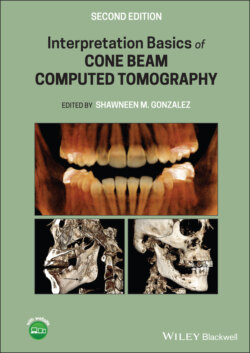Читать книгу Interpretation Basics of Cone Beam Computed Tomography - Группа авторов - Страница 20
Nonsurgical Treatment
Оглавление6 = Limited FOV CBCT should be considered if the clinical exam and intraoral radiographs are inconclusive for detecting a vertical root fracture.
Vertical root fractures are difficult to diagnose on intraoral radiographs with localized bone changes visualized first (Figure 2.3). The bone changes typically present with J‐shaped bone loss around the root with the fracture. CBCT imaging has increased sensitivity in detecting vertical and horizontal root fractures (Figures 2.4 and 2.5). Coronal, sagittal, and cross‐sectional views are the recommended views for detecting vertical root fractures. One concern when evaluating for fractures is teeth that have been endodontically treated, as the filling material causes artifacts that obscure small fractures and create pseudo‐fracture lines (Figure 2.6).
Figure 2.3. (a) Coronal view showing localized vertical bone loss (white arrow) along the facial root surface of a mandible molar. (b) Axial view showing localized bone loss (white arrow) along the facial root surface of a mandible molar.
Figure 2.4. (a) Pantomograph showing impacted maxillary right canine. (b) Periapical radiographs showing impacted maxillary right first premolar and canine with a dentigerous cyst. (c) Cross‐sectional slices showing a vertical root fracture on the maxillary right second premolar (white arrow) and dentigerous cyst associated with impacted canine.
Figure 2.5. (a) Cross‐sectional slices showing a horizontal root fracture (white arrow). (b) Cross‐sectional slices showing a horizontal root fracture (white arrow).
Figure 2.6. Axial views showing artifact streaking from an endodontically treated tooth obscuring the root when evaluating for root fractures.
The smallest root fracture that can be visualized on a CBCT scan is determined by the resolution/voxel size used. This is due to the Nyquist Theorem, which samples digitized information at 2 times the highest frequency. On a CBCT scan, this translates to the smallest root fracture visualized is twice the resolution/voxel size used. For example, if a resolution/voxel size of 0.2 mm is used, the smallest root fracture visible would be 0.4 mm.
7 = Limited FOV CBCT should be considered when evaluating nonhealing previous endodontic treatment.
8 = Limited FOV CBCT should be considered for nonsurgical retreatment.
